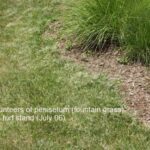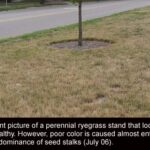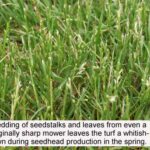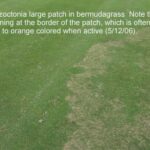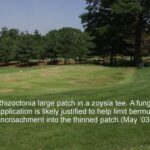Zac Reicher

Brown Patches in Lawns Could be Escaped Fountain Grass
Fountain grass and other ornamental grasses have added tremendously to the urban landscape. However, we are now seeing some of these grasses escape from the ornamental beds into the turf. One in particular is fountain grass (Penisetum spp) because it produces viable seeds which blow into surrounding turf and may germinate. Though most of the […]
Brown Patches in Lawns Could be Old Seedstalks
We have received a number of calls, email, and electronic photos inquiring about current brown patches in the lawn. Dollar spot is active throughout the state and could be causing problems in lawns. Dollar spot causes very noticeable lesions and cotton candy mycelium in the early morning. However, many of the patches that I have […]
Midwest Regional Turf Field Day on July 18
Don’t forget to register for the Midwest Regional Turf Field Day that will be held on July 18 at the W.H. Daniel Turfgrass Research and Diagnostic Center in West Lafayette. This is a great opportunity for turf professionals to view the latest in turfgrass research, talk to Purdue specialists about turf and ornamental issues, and […]
Bermuda suppression in zoysia?
Bermudagrass is one of the most difficult species to control due to its extensive stolon and rhizome system, aggressive growth, and tolerance to management and environmental extremes. It is even more difficult to control selectively in another warm season grass, thus it can be a problem wherever zoysiagrass is grown as the desirable turf. Recent […]
More on Nematodes and Indiana Greens
As our nematode survey continues, more questions are being asked about nematodes, their damage potential, etc. Following is an update on the survey: Do not attribute all vague symptoms to nematodes. Nematode populations and symptoms are extremely complex and cannot be diagnosed by anyone other than a nematologist. In other words, don’t panic. […]
Seedheads Make for Tough Mowing
Kentucky bluegrass, tall fescue, and perennial ryegrass are now producing seedheads. This natural phenomenon is induced by daylength and occurs every spring. Seedheads detract from the appearance of a turf because they grow quickly and unevenly and the tough seed stalks do not cut cleanly except with the sharpest of mower blades. After mowing, the […]
Aerification Following Preemergence Herbicide?
In theory, a barrier of preemergene herbicide is created in the soil and limites emergence of crabgrass. Any gap in this barrier could allow crabgrass to germinate. This is why a uniform application of preemergence herbicide is required and practices like power raking or aerification are usually not recommended after application. However, research consistently shows […]
Pink Snow Mold Active
The cool wet weather the last two weeks is favoring Microdochium nivale, the pathogen that causes pink snow mold (sometimes referred to as Microdochium patch). The color of pink snow mold scars indicates the activity of the patch. Straw colored patches are usually inactive. However, a rust to orange colored band or ring indicates an active […]
Rhizoctonia Large Patch in Bermudagrass
With the continued cool wet weather, Rhizoctonia Large Patch (RLP) is affecting bermudagrass fairways. Prior to widespread use of bermudagrass in southern Indiana and northern Kentucky, we thought RLP affected only zoysia and was thus known as zoysia patch. However, RLP caused serious thinning in bermudagrass in an occasional spring the last few years. This […]
Rhizoctonia Large Patch (Zoysia Patch) in Zoysia
With the continued cool wet weather, Rhizoctonia Large Patch (RLP or zoysia patch) is in high gear. This follows a warm winter that also encouraged RLP, which is the only major disease of zoysiagrass in Indiana. Like snow mold, a rust to orange colored band on the outside of the patch indicates activity. Though best […]
Nematode Damage in Golf Greens
We are suspecting more and more instances of actual nematode damage or at least secondary effects of nematodes in golf greens. Effects of nematode feeding would include yellowing, thinning, enhanced drought stress, and other symptoms reflective of a poor root system. Unfortunately, symptom expression may be enhanced or complicated by poor rooting from summer weather, […]
Considering Artificial Turf For Sports Fields?
Tremendous improvement in the artificial turfs has renewed interest in these turfs for sports fields. The decision to use artificial turf is difficult because these fields are a huge investment to install, maintain, and eventually replace. This technology is relatively new and still evolving, and thus questions abound on performance, safety, injury, maintenance costs, lifespan, […]
Time is Running Out for Preemergence Control of Crabgrass
April 15-20 usually marks the end of the window for applying traditional preemergence herbicides in central IN, a week earlier in southern IN, and a week later in northern IN. Though most preemergence herbicides do have minor post-emergence properties that will burn back small crabgrass (one or two leaf stage), this is not always reliable. […]
Spring Dandelion Control for Professionals
Many turf areas did not get treated for broadleaf weeds last fall because of the dry fall combined with the fairly early snowfall. Though fall applications are most effective for controlling broadleaf weeds, spring applications are warranted for new lawns or areas that did not get treated last fall. Spring applications will be most effective […]
Mark Your Calendars: Turf Field Day moved to July 18
The Midwest Regional Turf Field Day has been moved one week earlier to July 18 at the Wm H Daniel Turfgrass Research and Diagnostic Center in West Lafayette. This is a great opportunity for turf professionals to view the latest in turfgrass research, talk to Purdue specialists about turf and ornamental issues, and visit with […]
Attempting Ground Ivy Control
Ground ivy remains one of our toughest weeds to control. Following is our recommendation for maximizing control, based on experience and seven years of research: 1. Mow at 3” or higher. 2. Remove as much of the shade as possible. 3. Increase fertilizer up to 4.0 lbs N/1000ft2/yr fertilizing primarily in the fall 4. Make […]
Spring Dandelion Control Still Not as Effective as Fall Control
The annual bloom of dandelions is already here in southern and central Indiana. This marks the beginning of the second most effective period for controlling broadleaf weeds. The optimum time to control dandelions and other broadleaf weeds is in the fall and the second most effective time is in late spring, at or shortly after […]
Turfgrass Does not Perform Well in the Shade (Period)
We have received a ton of calls in the last week about improving shaded lawns. Following is a summary about shaded lawns: Turf does not perform well in the shade “Shade-adapted“ grass species and cultivars will always perform better in full sun compared to shade (regardless of what the label states) As […]
March 30-31 Workshop to complete requirements for pesticide licensing (3BRT)
Are you interested in making pesticide applications to your customers’ lawns? Indiana law says anyone who wants to apply turf pesticides (and that includes weed killers, weed and feed products, insecticides, and other over-the-counter pesticides) FOR HIRE must be licensed to do so. To obtain a commercial turf pesticide applicator FOR HIRE license, you’ll have […]
